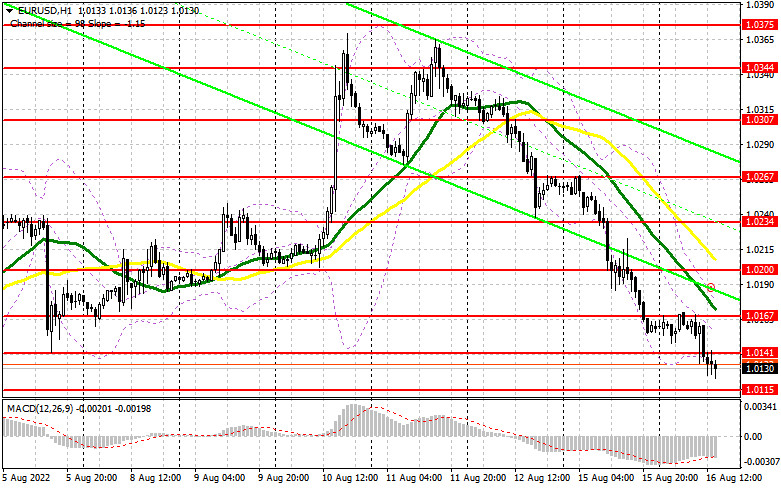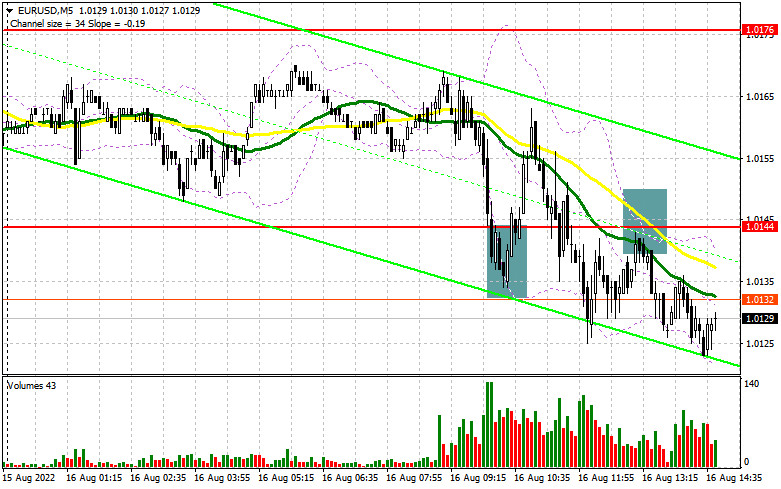In the morning article, I highlighted the level of 1.0144 and recommended making decisions with this level in focus. Now, let's look at the 5-minute chart and try to figure out what actually happened. The euro/dollar pair declined to 1.0144 in the first half of the day after weak data from Germany and the eurozone. It led to a false breakout and gave an excellent buy signal. Unfortunately, the pair failed to resume a steady rise. After moving up by 20 pips, the euro returned to 1.0144. Another test of this level triggered a breakout. The pair made an upward test, giving a sell signal. At the time of writing the article, traders were actively selling the pair. The technical outlook changed slightly in the afternoon.
What is needed to open long positions on EUR/USD
The US building approvals and housing starts reports, which are due today, are unlikely to be positive. This is why the bulls will have the chance to push the pair back to 1.0141. As I have already mentioned above, as long as trading is carried out above this level, the pressure on the pair will persist. If the upcoming reports are better than expected, the pair is sure to drop sharply to the nearest support level of 1.0115. If so, buyers will have to try harder to regain ground. Having failed to defend this level, the price will break out of a wide sideways channel, which was formed in early August this year. A false breakout of 1.0115 will give a buy signal with the prospect of a climb to the nearest resistance level of 1.0141, which the price missed in the first half of the day. Only a breakout and a downward test of this level along with weak US data will force the bulls to close their Stop-Loss orders, providing an additional buy signal. If so, it will open the way to 1.0167 where the moving averages are passing in negative territory. A more distant target will be a new high of 1.0200 where I recommend locking in profits. If EUR/USD declines and buyers show no activity at 1.0115, the pressure on the pair will escalate. The bulls may lose the upper hand. The best option for opening long positions will be a false breakout of 1.0082. You can buy EUR/USD immediately at a bounce from 1.0045 or a low of 1.0008, keeping in mind an upward intraday correction of 30-35 pips.
What is needed to open short positions on EUR/USD
Traders are unwilling to open long positions on the euro even at current lows. Sellers are not trying to push the pair lower following last week's sell-off. If the bulls continue to refrain from opening new positions, the pair is likely to lose momentum. Of course, the optimal scenario for opening short positions will be another false breakout of the resistance level of 1.0141. This level was formed in the first half of the day. This scenario may come true if US economic reports are weak. The euro is likely to reach 1.0115. A breakout and a drop below this level, as well as an upward test, will generate an additional sell signal. The bulls will have to close their Stop-Loss orders. If so, the price will slide to 1.0082. A decline below this level will put an end to the bull market. It will also open the way to 1.0045 where I recommend closing all short positions. A more distant target will be the 1.0008 level. If EUR/USD rises during the US session and the bears show no energy at 1.0141, the bulls are likely to build an uptrend. In this case, I would advise you to postpone short positions to 1.0167 but only after a false breakout of this level. You can sell EUR/USD immediately at a bounce from a high of 1.0200 or a high of 1.0234, keeping in mind a downward intraday correction of 30-35 pips.

COT report
The COT report (Commitment of Traders) for August 9 logged a sharp increase in both short and long positions. However, the number of short positions turned out to be bigger, which indicated the gradual end of the bear market and an attempt to find the bottom after reaching the parity level. Last week, US fresh macro stats were released, which turned everything upside down. The CPI report showed the first slowdown in inflation after reaching a peak of 10.0%. It fueled demand for risky assets. As seen on the chart, risk aversion soon returned to the market. Traders are unwilling to increase long positions due to the risks of a global recession. No crucial economic reports are expected this week that could facilitate the growth of the euro. Therefore, the euro is likely to stay in the sideways channel. There could hardly be sharp trend reversals before the fall of this year. The COT report revealed that the number of long non-commercial positions rose by 8,396 to 200,088, while the number of short non-commercial positions jumped by 4,121 to 234,624. At the end of the week, the total non-commercial net position, although it remained negative, climbed slightly to -34,536 from -39,811, signaling a shift to the bull market. The weekly closing price climbed to 1.0233 against 1.0206.

Signals of technical indicators
Moving averages
EUR/USD is trading below 30- and 50-period moving averages, indicating a further fall in the euro.
Remark. The author is analyzing the period and prices of moving averages on the 1-hour chart. So, it differs from the common definition of classic daily moving averages on the daily chart.
Bollinger Bands
In case of a rise, the upper border of 1.0185 will act as resistance.
Definitions of technical indicators
- Moving average recognizes an ongoing trend through leveling out volatility and market noise. A 50-period moving average is plotted yellow on the chart.
- Moving average identifies an ongoing trend through leveling out volatility and market noise. A 30-period moving average is displayed as the green line.
- MACD indicator represents a relationship between two moving averages that is a ratio of Moving Average Convergence/Divergence. The MACD is calculated by subtracting the 26-period Exponential Moving Average (EMA) from the 12-period EMA. A 9-day EMA of the MACD called the "signal line".
- Bollinger Bands is a momentum indicator. The upper and lower bands are typically 2 standard deviations +/- from a 20-day simple moving average.
- Non-commercial traders - speculators such as retail traders, hedge funds and large institutions who use the futures market for speculative purposes and meet certain requirements.
- Non-commercial long positions represent the total long open position of non-commercial traders.
- Non-commercial short positions represent the total short open position of non-commercial traders.
- The overall non-commercial net position balance is the difference between short and long positions of non-commercial traders.











